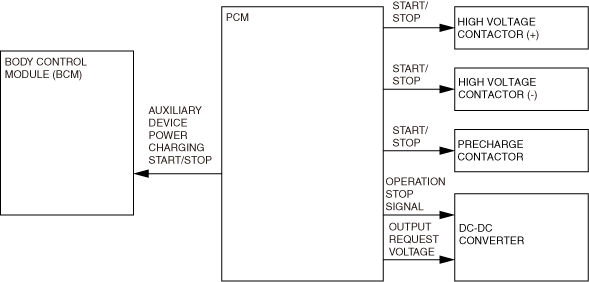AUXILIARY DEVICE POWER CHARGING SYSTEM
id304000104100
Outline
• Vehicle's electrical devices such as the body control module (BCM) are activated each time the user opens or closes the door even when the main power is switched OFF. Frequent activation of the vehicle's electrical devices while the main power is switched OFF consumes lead-acid battery power and leads to lead-acid battery depletion. In addition, if the lead-acid battery power decreases, the high voltage contactors cannot be driven and the EV system will not be able to start.
• The PCM prevents lead-acid battery depletion by charging it with the high voltage battery power if the lead-acid battery power may decrease due to frequent activation of the vehicle's electrical devices while the main power is switched OFF.
Block Diagram
Operation
• The PCM determines that auxiliary device power charging is necessary if the activation time of the vehicle's electrical devices is long when the main power is switched OFF.
• When all of the following conditions are met after the PCM determines that auxiliary device power charging is necessary, it drives the high voltage contactors, connects the high voltage circuit, and activates the DC-DC converter to charge the lead-acid battery with the high voltage battery power. (See
HIGH VOLTAGE CIRCUIT START/CUT OFF CONTROL.) (See
DC-DC CONVERTER CONTROL.)
-
― Selector lever is in P position
― Main power is switched OFF
― High voltage battery state of charge (SOC) is specified value or more
― ROOM fuse is installed
― Not in connected vehicle maintenance mode (MyMazda App connected vehicle)
• The PCM charges the lead-acid battery for 10 min. After charging, the PCM stops the DC-DC converter, cuts off the high voltage circuit, and sends an auxiliary device power charging completion signal to the body control module (BCM) via CAN communication.
• When the PCM detects that any of the charging start conditions is not met during charging, it stops the DC-DC converter, cuts off the high voltage circuit, and sends an auxiliary device power charging stop signal to the body control module (BCM) via CAN communication.
